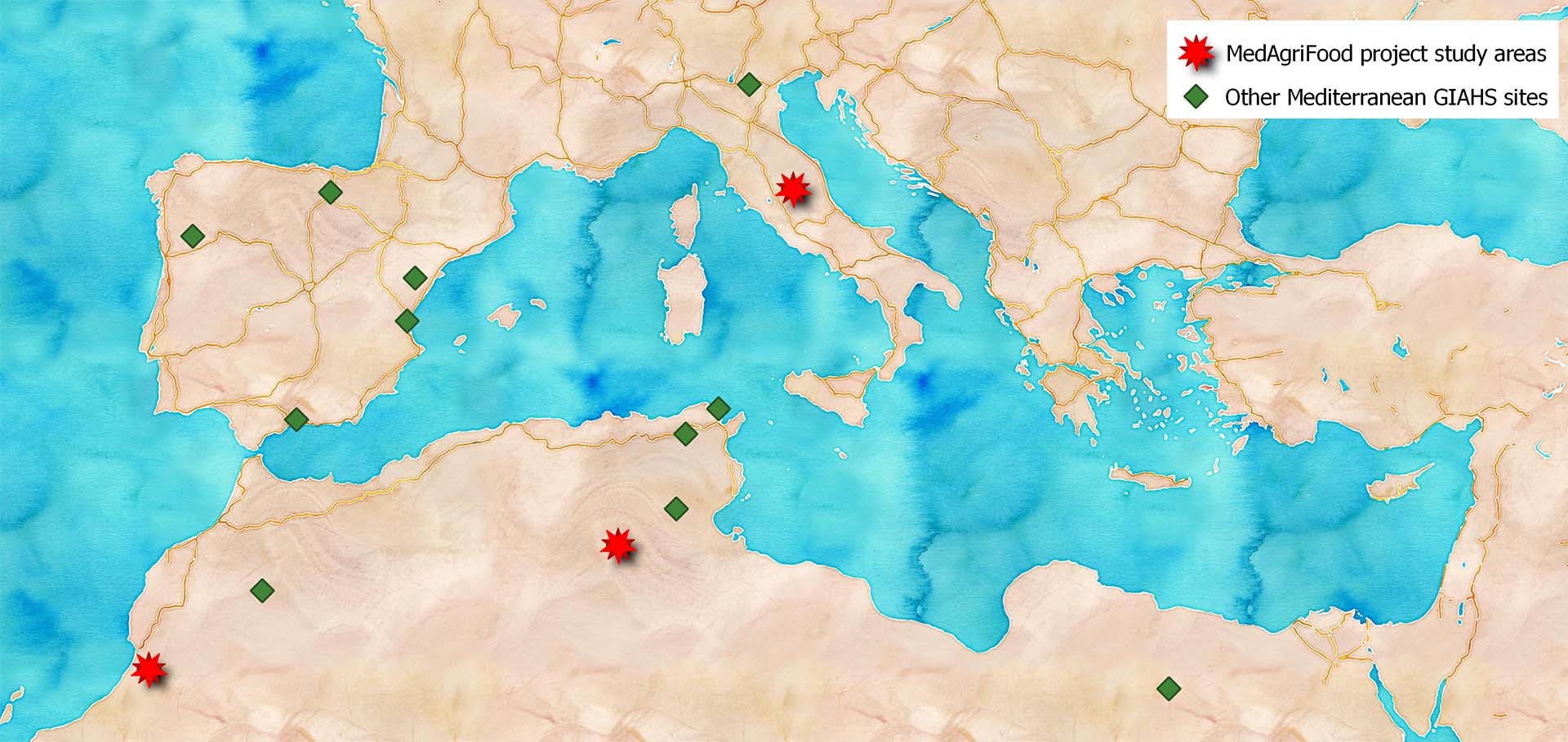MedAgriFoodResilience is supported by the FAO GIAHS Programme Secretariat.
MedGIAHS Network

Barroso Agro-sylvo-pastoral System
(Portugal). Barroso is a composite landscape made by pastures, meadows, forests and small cultivations, with a predominance of smallholdings and cattle, sheep and goat pastoral farming, which contributes significantly to household economies and plays an important social role. This is a system typical of mountainous regions, with poor utilization of external inputs and very few surpluses.
The Agricultural System of Valle Salado de Añana
Valle Salado is located in the town of Salinas de Añana where, thanks to the existence of a geological phenomenon called Diapir and to the injection of fresh water into the bubble, a number of salt water springs emerge at the highest part of the valley. This salt water is channeled by an ingenious system of canals to the salt pans where it evaporates to form salt.
Malaga Raisin Production System in La Axarquía (Spain)
The raisin production in Axarquía has gone through centuries and different civilisations until today, still representing an important economic resource for local farmers. Preserving this grape-growing system and its sun-drying transformation process is essential to maintain the landscape, as it prevents erosion and desertification processes and it is an example of how the people of the area relate with their territories and their cultural traditions.
The Agricultural System Ancient Olive Trees Territorio Sénia (Spain)
The existence of 5,000 ancient olive trees makes this territory a unique place offering numerous opportunities for rural development based on olive oil production and on rural tourism, significantly contributing in improving the living conditions of local people. In addition, there are different varieties of olives on each farm, to improve the pollination of flowers and future varieties of olives, contributing to biodiversity.
Historical Irrigation System at l'Horta de València (Spain)
L’Horta de Valencia is formed by an irrigation system that allows the cultivation of different crops and that reflects a culture of adaptation to the climatic conditions so that could be considered a potential sustainable solution to modern problems. More than 1200 years ago the Muslims had brought in this area a diet composed of plant and animal products typical of rainy regions, therefore it was necessary to create an irrigation system to allow species adaptation to the Mediterranean climate.
Soave Traditional Vineyards (Italy)
Soave traditional vineyards are an agro-economic system that provide income to more than 3,000 families. This system has kept traditional ways to train the vines and succeeded in distributing income and security to the various stakeholders involved in the production chain, such as grapes producers, wine producers and bottlers, even during the most difficult periods. Even though it is characterized by small or micro estates, it has succeeded in remaining competitive thanks to cooperation and innovation.
Siwa Oasis (Egypt)
Siwa oasis is one of the best illustrations of farmers’ ingenuity to adapt agriculture to very harsh climatic conditions. Situated in a very dry region, this oasis provides an effective way to grow food, livestock and preserve wild flora and fauna, relying on very scarce water resources. Recognized as a very ancient agrarian area, Siwa oasis is a repository of distinctive date palm varieties. This system is based on date palms combined with other crops, such as olive trees and alfalfa allowing local people to respond to different needs.
Oases System in Atlas Mountains (Morocco)
In the High Atlas of Morocco, local communities, despite the scarce water resources, created an adapted system to get food, as well as all the necessary products to survive. Their system integrates vegetables, cereals and fruits production with pastures for animals through crop rotations and agroforestry techniques. The whole system is organized with a remarkable w
Gafsa Oases (Tunisia)
Gafsa oasis is a green area situated in the dry lands of Tunisia. The system of production is based on water management but also on a structure based on three layers: cereals and vegetables are grown in the lower one, fruit trees in the intermediate one, and date palms in the upper one. Local communities have been living in the Gafsa oasis for centuries, and nowadays the oasis is still an important source of income and agricultural production for people in the region.
Hanging gardens from Djebba El Olia (Tunisia)
Perched on the heights of Mount el Gorrâa, the gardens of Djebba el Olia form a unique agroforestry system. At an altitude of 600 m, the local community shaped the mountainous landscape by building dry stone terraces. Backed by an efficient irrigation system, the hanging gardens of Djebba El Olia offer many food resources to their owners.
Ramli agricultural system in the lagoons of Ghar El Melh (Tunisia)
Ramli, meaning on sand, are agricultural practices that consist of growing crops on sandy substrates. These very singular gardens were created in the 17th century by the Andalusian diaspora to cope with the lack of cultivable land and fresh water. This ingenious and unique system is based on a passive irrigation system where the roots of the plants are fed in all seasons by the rainwater stored and floating on the surface of the sea water through the movements of the tides.
The author(s)/editor(s) acknowledge the financial support through the partners of the Joint Call of the Cofund ERA-NETs SUSFOOD2
(Grant N° 727473) and FOSC (Grant N° 862555).
© Copyright 2022 Dipartimento di Scienze e Tecnologie Agrarie, Alimentari, Ambientali e Forestali (DAGRI) Università degli Studi di Firenze UNIFI Via San Bonaventura 13, 50145 Florence P.IVA/Cod.Fis 01279680480 Privacy Policy





